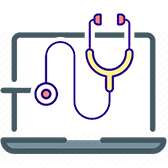
You may encounter the USB Device Not Recognized error when accessing a USB external hard drive. This article offers solutions to this issue.
Symptoms
You can see the following problem when attempting to retrieve data on an external USB hard drive:
Windows cannot recognize a USB device connected to this Computer because it is broken.
Cause
Any of the following circumstances can result in this problem:
The USB driver that is currently installed has degraded or become faulty.
Your Computer needs to be updated for issues that could conflict with Windows and an external USB hard drive.
Windows can be lacking other crucial updates or have hardware or software problems.
Your USB controllers may have deteriorated or become unstable.
Your external drive may be in selective suspension.
Updated drivers might be required for your PC's motherboard.

Solution 1:
-
Uninstall the external hard disc, then reinstall it.
-
When the USB driver that is currently loaded becomes unstable or corrupt, this technique fixes the problem.
-
Enter Device Manager in the Search box after choosing Start.
-
Choose Device Manager from the list that was returned.
-
Disk Drives should be chosen from the list of hardware.
-
Select "Uninstall" by holding down the Control key while clicking the USB external hard disc that has the problem.
-
Unplug the USB cable after removing the hard disc.
-
After one minute, reattach the USB cable. The driver needs to load automatically.
-
In Windows Explorer, look for the USB drive.
Note
If you plug your USB external hard drive into a non-powered USB hub, the external drive might not have enough power to function. Put it directly into your PC as an alternative. Proceed to resolution 2 if this approach does not resolve your problem.
Resolution 2:
-
Apply hotfixes to Windows 7 to remedy any problems that may be present.
-
This technique's hotfixes can address a problem with a USB external hard drive and Windows.
-
Visit KB976972. You run into issues when transferring data via USB from a PC running Windows 7 and equipped with an NVIDIA USB EHCI chipset and at least 4 GB of RAM.
-
Choose Download the update package that is appropriate for your version of Windows 7 under Update information.
-
If you are unclear about the Windows 7 version you are using, click the Start button and hold down the mouse button while selecting Computer> Properties.
-
You're using Windows 7 64-bit if the 64-bit Operating System is shown next to the System type.
-
You are using the 32-bit (x86) edition of Windows 7 if the 32-bit Operating System is mentioned next to the System type.
-
Choose Continue. Select Yes if a User Account Control permission request appears.
-
Select Open > Download.
-
Within 30 seconds, the download ought to begin. Select Start Download > Open if it doesn't.
-
To finish the download and installation, adhere to the on-screen directions.
-
Visit KB974476. When a USB device in Windows 7 restarts from the USB Selective Suspend state, the machine becomes unresponsive.
-
Choose View
-
Review the licensing agreement if requested. I Accept should be selected if you accept the terms.
-
Enter your email in the boxes below after selecting the checkbox next to the Windows 7 version.
-
Select Request hotfix after entering the word verification.
-
Examine your email. Microsoft will send you an email with a download link for the hotfix soon. To download and install the hotfix, select the link and adhere to the prompts on the screen.
-
Switch off your Computer.
If the issue is still present, move on to the next step :

Resolution 3
-
Install the most recent Windows updates.
-
The most recent device drivers for your USB external hard drive will be installed using this procedure.
-
You may choose Windows Update from the results list after clicking the Start button and entering "Windows Update" in the search box.
-
To check for updates, choose. Select Review optional updates after the scan is finished.
-
Install updates after checking the box next to the updates.
-
Review the licensing agreement if asked, then click I Accept.
-
Download and install the updates by adhering to the on-screen directions.
-
Reboot your Computer if requested.
-
If the issue persists, move on to resolution 4.
Also Read: How To Update Google Chrome
Also Read: Graphics Card for Laptops: 5 Best Cards in India 2022

Resolution 4
-
Reinstall USB controllers as the fourth solution
-
When the USB driver that is currently loaded becomes unstable or corrupt, this procedure fixes the problem.
-
Device Manager can be found by selecting Start, searching for it in the search bar, and then setting it.
-
Expand the controllers for the Universal Serial Bus. Select Uninstall by pressing and holding (or right-clicking) on a device. Repeat for every gadget.
-
Restart your Computer after you're finished. Your USB controllers will be installed automatically.
If the issue is still present, move on to solution 5.
Resolution 5
-
Turn off the USB selective suspend setting (resolution 5)
-
Using this technique, you can stop your USB external drive from shutting down.
-
Choose a power plan after selecting the Start button, power plan, and the Search box.
-
Select Change Plan Settings next to the plan that is presently selected.
-
Choose Modify advanced power settings.
-
Expand USB Settings > USB Selective Suspend Settings by selecting the box.
-
Disabled is the third option on the drop-down menu after choosing Plugged in.
-
On a laptop, click Battery, choose the drop-down menu, and finally click Disabled.
-
Select OK > Apply.
You should move on to resolution 6 if this doesn't fix your problem.
Resolution 6
-
Install the most recent chipset drivers for your motherboard.
-
Using this technique, you can get your Computer to recognize your USB external hard drive by updating the motherboard's chipset drivers.
-
The motherboard manufacturer should be listed in the documentation for your Computer.
-
Visit the support page for the manufacturer of your Computer. See Computer manufacturers' contact information for a list of support websites for various computer manufacturers.
-
To find the correct drivers for your motherboard, search their website. Contact the maker of your Computer for assistance.
Conclusion:
I won't say much, as the blog has informed you about USBs not being recognized in Windows 10. It is an easy process, and you can use it for various purposes.
Frequently Asked Questions
Popular Services
- MacBook Battery Replacement Cost
- HP Printer Repair in Delhi NCR
- Dell Laptop Repair
- HP Laptop Repair
- Samsung Laptop Repair
- Lenovo Laptop Repair
- MacBook Repair
- Acer Laptop Repair
- Sony Vaio Laptop Repair
- Microsoft Surface Repair
- Asus Laptop Repair
- MSI Laptop Repair
- Fujitsu Laptop Repair
- Toshiba Laptop Repair
- HP Printer Repair Pune
- Microsoft Surface Battery Replacement
- Microsoft Surface Screen Replacement




